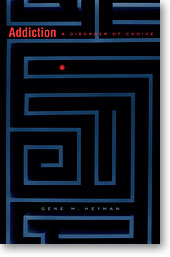 I found an old essay by Gene Heyman which covers many of the same points he eventually covered in greater depth in his 2009 book Addiction: A Disorder of Choice. For those who are nerdy about addiction and want to read a deeply philosophical piece on how it is a choice, I highly recommend it. Here’s a link to the paper, Resolving The Contradictions In Addiction, and here’s an excerpt:
I found an old essay by Gene Heyman which covers many of the same points he eventually covered in greater depth in his 2009 book Addiction: A Disorder of Choice. For those who are nerdy about addiction and want to read a deeply philosophical piece on how it is a choice, I highly recommend it. Here’s a link to the paper, Resolving The Contradictions In Addiction, and here’s an excerpt:
These stories illustrate an important and unresolved problem in the understanding of human behavior. Drug consumption is a goal oriented act. The behaviors are learned, not reflexive or innate. It requires planning, effort, and in some cases artfulness to secure drugs in the amount necessary for maintaining an addiction. Yet, according to the diagnostic manuals (e.g., DSM-III-R and ICD-10), the feature that defines addiction is drug use which is “out of control” or “compulsive.” By these phrases, the manuals mean that addicts “take more drug than they initially intended,” that drug use persists despite a wide array of ensuing legal, medical, and social problems, and that after periods of abstinence, however long, addicts relapse. In other words, according to authoritative clinical opinion, addiction is not simply frequent drug use, it is loss of control over drug use.
But how can a behavior be “out of control” or “compulsive” yet require planning? For example, if addiction is interpreted as a compulsive, out of control state, but drug seeking is a coordinated series of directed learned behaviors, then logic yields apparently meaningless statements such as “addicts are those who plan to use drugs in uncontrolled ways.” On the other hand, biographical and clinical data show that addicts repeatedly attempt to remain sober, but, despite their efforts, fail to do so (Alcoholics Anonymous, 1976; American Psychiatric Association, 1987; World Health Organization, 1992). These puzzles are at the heart of the long-standing debate as to whether addiction is best classified as an involuntary state, e.g., a disease, or a voluntary state e.g., a preference.

I recently finished Heyman’s book, and I want to read Schaler’s now.
Overall, I thought Heyman’s book was great. I especially appreciated the ideas about local versus global choice.
But I was a bit confused about what he said about AA in the last chapter. He mentioned some relatively recent study by George Vaillant that showed AAs’ effectiveness. I’m familiar with Vaillant’s earlier study which quite conclusively demonstrated AA’s harmfullness, and it seemed strange for Heyman to not mention that (unless I missed it). Any thoughts?
Hi Jonas,
Both the recovery culture (which includes self-help groups such as AA) and the disease theory of addiction are sacred cows. It seems to me that taking on one of the sacred cows is tough enough and will likely get you labeled as a quack and charlatan. Taking on two of the sacred cows, will ensure that you’re completely written off and shunned by the academic world.
I think Heyman is focused on his point that addiction treatment doesn’t seem to raise success rates – citing AA as successful would only bolster that argument, since it is decidedly not medical (even though many refer to it as “treatment”, including SAMHSA and NIAAA). I think he’s so focused on his disease points that he may have missed some of the more damning stuff about AA.
If you were disappointed by that, then you will also be disappointed by Schaler’s book – he also gives credit to AA, and tries to make the point that we needn’t be spending money on treatment when the free stuff (12-step meetings) works just as well. I disagree with both these guys on this point. I think if they examined it further, they’d change their opinion on AA, but as I said, I think they’re both focused so heavily on their points about disease and treatment that they might’ve missed some of the downsides to AA. It’s unfortunate, because although these are among my favorite books, and highly important groundbreaking works of brilliance, I have a hard time recommending them to my students because of this flaw about 12-step involvement.
-Steven
That is is a good explanation. As I’ve been learning more about this, I’ve been amazed to see how many people seem wont to criticize AA / treatment centers.
I guess I’m left to wonder if Heyman didn’t put much time into that section or if he just didn’t want to go there. I still thought the sections about choice and behavior were very worthwhile.